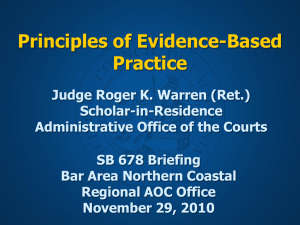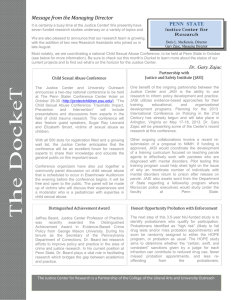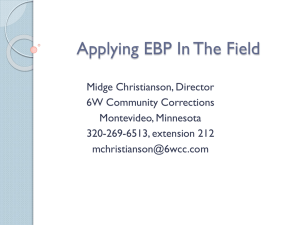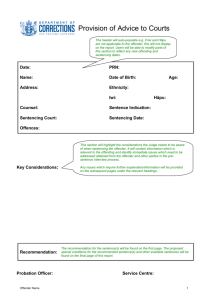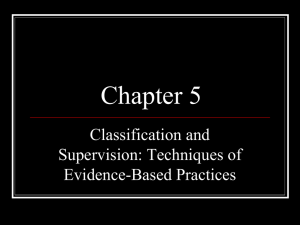Protect community safety, reduce crime and assist victims, through
advertisement
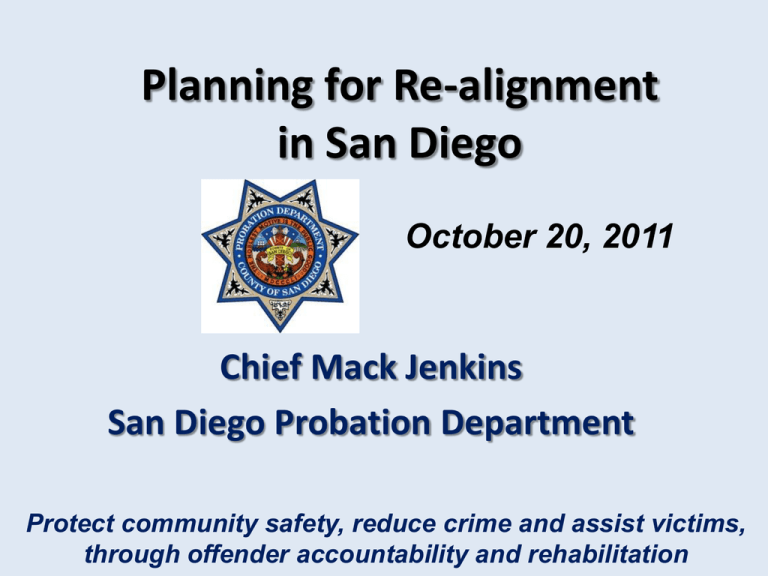
Planning for Re-alignment in San Diego October 20, 2011 Chief Mack Jenkins San Diego Probation Department Protect community safety, reduce crime and assist victims, through offender accountability and rehabilitation EVIDENCE-BASED PRACTICE Strategic Planning •Representation from across the organization •Reviewed all relevant processes to •Improve efficiency •Reduce recidivism 2 STRATEGIC PLAN FOR THE IMPLEMENTATION OF EVIDENCE BASED PROGRAMS: SAN DIEGO COUNTY PROBATION Protect community safety, reduce crime and assist victims, through offender accountability and rehabilitation Goal Objectives Ensure availability of appropriate tools enabling staff to accurately assess offenders for risk and needs at each stage of the probation process 1.Conduct gap analysis of general assessment tools in Adult Field Services (AFS) /Juvenile Field Services (JFS) /Institutional Services (IS) in order to identify strengths and weaknesses of tools 2.Evaluate specialty tools 3.Provide Information and recommendations to all services regarding use of assessment tools 4.Disseminate Information in easy to read format Assign offenders to the appropriate level of supervision based on their risk and need factors 1.Develop clear and concise standards for re-assignment to other levels of supervision 2.Design, develop and implement an organizational infrastructure and corresponding framework of practices, protocols, and policies that support Quality Assurance Develop case plan standards based upon the risk / need assessment and level of supervision 1.Identify the case planning tool to be used by JFS, AFS and IS 2.Ensure that there is a seamless continuum between IS and JFS assessments and case planning 3.Create Needs domains / referral matrices for JFS and AFS 4.Integrate community resource directory with case planning tool 5.Ensure that all staff have the training needed to use case planning component of assessment tool and community resource directory appropriately In support of the “balanced approach”, establish guidelines for incentives and sanctions throughout juvenile, adult and institutions to provide effective responses to offender behavior, in order to reduce recidivism 1.Develop subject matter experts on EBP incentives / sanctions 2.Develop incentive and sanctions models for adult, juvenile and institutions 3.Train Probation staff on incentive/sanctions model Improve the ability of information technology (IT) to support the department for the purpose of holding offenders accountable, providing rehabilitative services, and supporting evidence based practice 1.Create a governance committee 2.Create committee charter 3.Commence committee meetings Develop procedures / practices that incorporate staff competencies into the appraisal process Improve the quality and consistency of programs 3 SB 678 PLAN San Diego County Probation Leadership Academy • In-depth training for Adult Field Services directors and supervisors • Enhance leadership skills to integrate evidence-based practices Increase Accountability of High-Risk Probationers • Administrative incentive and sanctions continuum • Integrated Behavioral Intervention Strategies (IBIS) 4 SB 678 PLAN Enhanced Comprehensive Services • Services available to address criminogenic needs • Substance abuse treatment • Cognitive Behavioral interventions • Vocational/Educational • Health/Mental Health services Evaluate the Impact of the SB 678 Plan • Impact of high risk supervision model on recidivism • Impact of SB 678 plan on criminal justice system costs 5 SAN DIEGO COUNTY PROBATION SUPERVISION MODEL Use Assessment Tools Match Supervision to Risk Level Create Individualized Case Plans Evidence-Based Practice Strategic Planning Employ Incentives and Sanctions Continuum Educate Stakeholders Improve Officer Skills Manage/Reduce Detention Population Screen Tools for Diversion Strategies Explore Detention Alternatives Supervise Probationers to Reduce Recidivism using Integrated Behavioral Intervention Strategies (IBIS) and Case Management Motivational Interviewing Cognitive Behavioral •Collaborative style of conversation to strengthen a person’s own motivation to change •Brief •Complementary with other tools ASSESSMENT • Use empirical assessment tool •Assign to a supervision level by risk •Understand criminogenic needs Incentives and Sanctions •Thinking affects behavior • Antisocial and unproductive thinking causes antisocial and unproductive behavior • Thinking can be influenced • We can change how we feel and behave by changing how we think PLANNING • Ensure plan is comprehensive, ongoing and dynamic •Include probationer •Pay attention to stage of change LINKING • Make appropriate referrals •Use Community Resource Directory •Engage community supports • Swift, certain and consistent • Administrative, not adversarial • Proportionate to behavior and risk level MONITORING • Provide incentives •Apply swift and certain sanctions •Acknowledge relapse triggers •Revise case plan as needed ADVOCACY • Working with and on behalf of probationers to obtain services and resources •Increase probationer’s belief in the ability to succeed 6 San Diego County Realignment Goals • Efficiently use jail capacity • Incorporate reentry principles into in-custody programming • Incorporate evidence-based practices into supervision and case management of Post Release Offenders; encourage judges to use evidence-based practices in sentencing San Diego County Plan Components 1. Enhance Pre-Trial Processes to More Effectively Utilize Current Jail Capacity 2. Improve and Streamline Felony Settlement 3. Encourage the use of Evidence-Based Practices into Sentencing for Felony Offenders 4. Employ Alternative Custody Options and In-custody Programming 5. Provide Evidence-Based Supervision and Intervention Services for Post Release Offenders Component 1 - Enhance Pre-Trial Processes to More Effectively Utilize Current Jail Capacity • Strategies: – – – – Request the Court to consider modifying bail schedules Use home detention and electronic monitoring Use Work Furlough for eligible pre-trial inmates Use of residential treatment beds in lieu of pre-trial custody Component 2 - Improve and Streamline Felony Settlement • Strategies: – Conduct assessments to identify opportunities for early case disposition – Reduce the number of hearings for low-risk offenders – Expand the use of existing Collaborative Courts – Train staff on evidence-based risk assessments – Expedite Proposition 36 Diversion and Deferred Entry of Judgment cases Component 3 - Encourage the Use of Evidence-Based Practices in Sentencing for Felony Offenders Provide actuarial risk assessment information to all sentencing judges and to the attorneys • Sentencing parties would advocate to judges: – – – – Utilizing actuarial assessments Existing Court Rules New legislative provisions Trainings • Sentencing options for the Judge: – – – – – Felony Probation to the Court Formal Probation Split Sentencing and Mandatory Supervision Full Sentencing State Prison Component 4 - Employ Alternative Custody Options and In-Custody Programming • Strategies: – Use of alternatives to custody • • • • Work Release/Work Projects / Work Furlough Home confinement/electronic monitoring GPS supervision Sheriff and Probation to explore work and fire camp options – Expand in-custody treatment programming Component 5 - Provide Evidence-Based Supervision and Intervention Services for Post Release Offenders (PROs) • Strategies – Employ Evidence-Based Practices – Risk Based Case Planning and Supervision – A Balanced Approach of Incentives and Sanctions • Intermediate Sanctions • Community based re-entry services – Co-locate Post Release Probation Officers within various police agency offices throughout the County SERVICE PRIORITIES UNDER LOCAL SUPERVISION • Create Day Reporting Centers • Drug Treatment • Residential • Outpatient • Sober Living/Housing • Detox Beds • Mental Health Treatment • Medical/Dental • Employment • Vocational training and placement • Transitional jobs • Cognitive Behavioral Treatment • Literacy/Education • Stabilization Assistance • Work tools, interview clothing, SSI card, bus passes, clothing, groceries, haircuts • Housing 14 PERFORMANCE MEASURES Protect community safety, reduce crime and assist victims, through offender accountability and rehabilitation Ensure that 70% of juvenile probationers will complete their probation without being convicted of a new crime Protect community safety, reduce crime and assist victims, through offender accountability and rehabilitation Ensure that 60% of adult probationers will complete their probation without being convicted of a new crime 15 Adult Recidivism Rate 2008 - 2011 Year 16 PERFORMANCE MEASURES Protect community safety, reduce crime and assist victims, through offender accountability and rehabilitation Contact 95% of available victims and inform them of their right to restitution and a victim impact statement Protect community safety, reduce crime and assist victims, through offender accountability and rehabilitation Conduct 5,000 searches of homes of adult and juvenile probationers to ensure that they are not in possession of illegal contraband such as weapons, drugs, child pornography and/or gang related paraphernalia 17 PERFORMANCE MEASURES Protect community safety, reduce crime and assist victims, through offender accountability and rehabilitation Increase percent of youth in custody over the age of 16 who receive employment readiness services from 73% to 75% Protect community safety, reduce crime and assist victims, through offender accountability and rehabilitation Increase the percent of youth assessed to have substance abuse needs who receive substance abuse 18 services from 77% to 80% Performance Measures and Outcomes • Recidivism – Post Release Offenders – N3s • Use of Jail Space – Length of stay for various populations • Amount and type of in custody programming • Use of risk / need assessment in sentencing, supervision and case management

